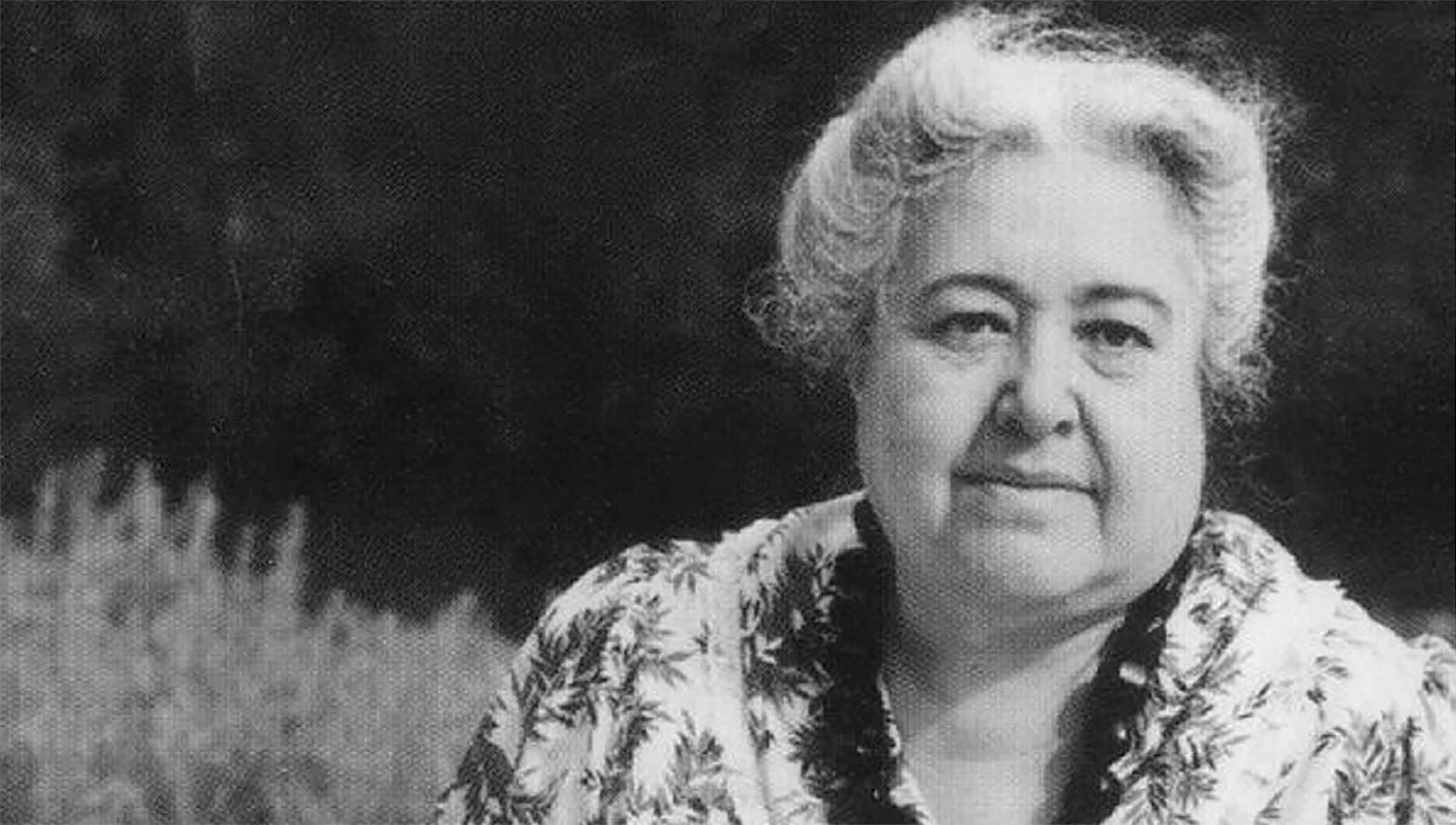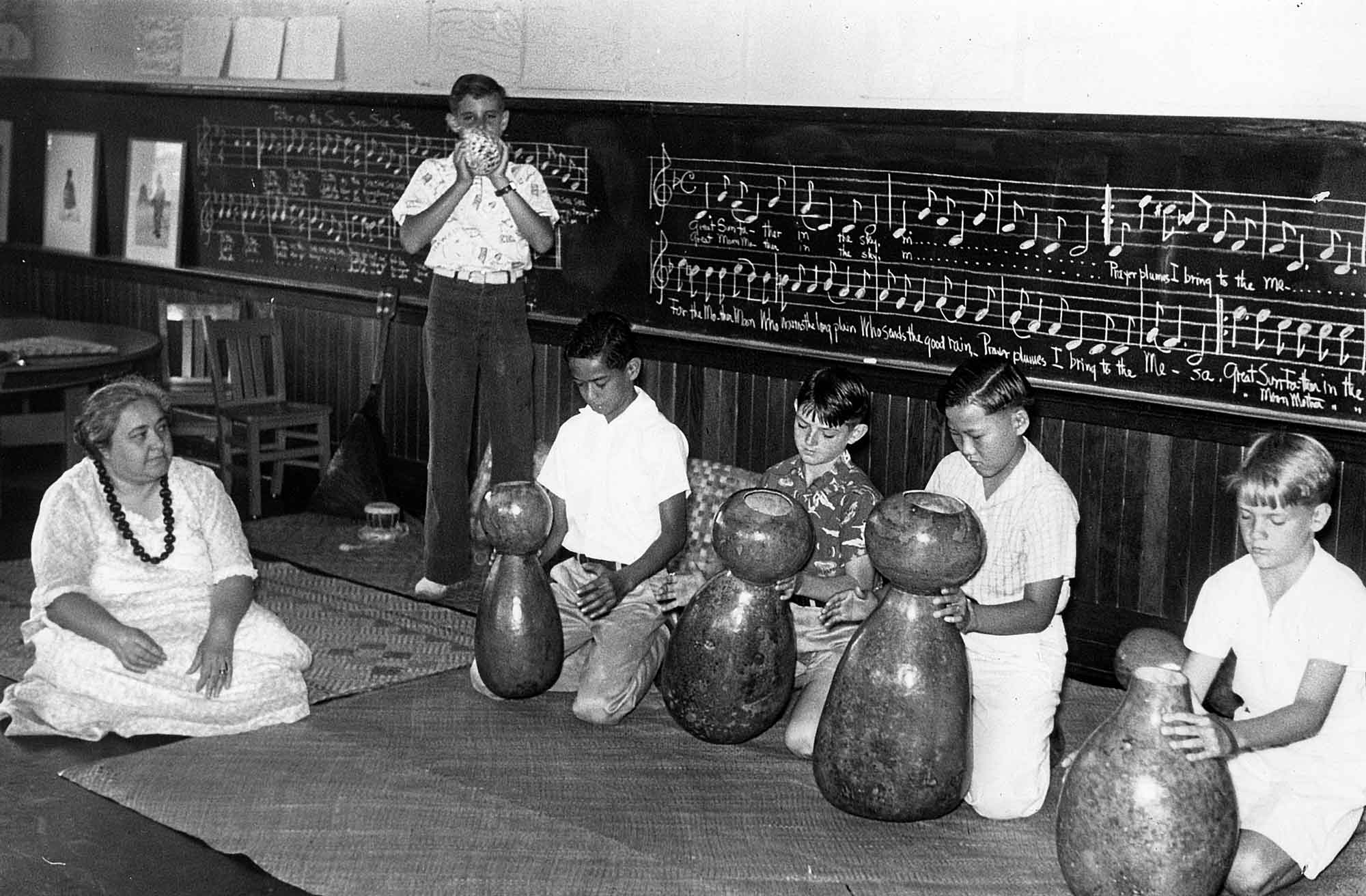
The Mary Kawena Pukui Learning Commons has been named for teacher, storyteller, historian and visionary
Mary Abigail Kawenaʻulaokalaniahiʻiakaikapoliopelekawahineʻaihonua Pukui.
Mrs. Pukui is one of Hawai‘i’s most renowned ʻōiwi scholars and is universally valued as one of the 20th century’s uniquely influential resources in Hawaiian cultural preservation. Punahou was a beneficiary of Mrs. Pukui’s knowledge of storytelling, mele and hula as a teacher from 1936 – 1941, and her impact and influence endures. During the late 1930s, she taught in the Junior School, meeting with groups of children to teach Hawaiian language, stories, games and music, and creating curriculum in Hawaiian studies, or ‘ike Hawai‘i, at Punahou.
With Punahou Head of K– 6 Music, Jane Lathrop Winne (1903), Mrs. Pukui expanded and strengthened Punahou’s elementary school Hawaiian Studies program. Later in 1961, they published a book of Hawaiian proverbs for children entitled “‘Ōlelo No‘eau a Ka Hawai‘i,” illustrated by Jessie Shaw (1906) Fisher.
Through the early 1940s Mrs. Pukui taught at the Kamehameha Schools and continued her work at the Bishop Museum. She dedicated 25 years of employment to the Bishop Museum, yet her contributions in translation and consultation extended over 40 years and carried on through her daughter Patience Nāmaka Bacon’s tenure with the museum. For her seminal scholarship, she was awarded a Doctor of Letters by the University of Hawai‘i in 1960; a Doctor of Arts and Letters by the Church College of Hawai‘i in 1974; named a Living Treasure of Hawai‘i in 1976; nominated for the Nobel Prize in Literature in 1981; and inducted into the Hawaiian Music Hall of Fame in 1995. Thanks to her work in translation and preservation, Mary Kawena Pukui is often credited with making possible the Hawaiian Renaissance of the 1970s.
Mrs. Pukui remained a friend and advisor to Punahou for many years, returning in April 1972 to retell the story of Ka Punahou to a new generation of children and watch them dance her hula. Her voice, influence and direction continue to guide our work in ‘ike Hawai‘i and have impacted strategic planning and the School’s mission to this day.
Mrs. Pukui had great aloha for Punahou. She shared that, “This school shall be a Spring of Wisdom. As the hala tree stands firm through wind or storm, so shall the children of this school stand strong and brave through joy and sorrow. And just as the hala tree has many uses, so shall these children be useful to Hawai‘i.”
These words inspired Punahou School’s new mission, adopted in 2023, which reflects the spiritual, social and ethical framework at the heart of a Punahou education. The mission statement reads:
We are children of Ka Punahou, the new spring.
From under the hala tree, we weave a mat that seats many,
our home to dream and discover our purpose
and kuleana to Hawai‘i and the world.
Naming the Learning Commons for an intellectual activist and inspirational teacher recognizes the courage, dedication, creativity and deep care that Mrs. Pukui had for the children of Punahou and Hawai‘i. Artifacts and scholarship of Mary Kawena Pukui, including photos, audio, moving images, text, and a dedicated space for ‘ike Hawai‘i, will be prominent features of the Learning Commons, and the decor will evoke her influence.
The new Mary Kawena Pukui Learning Commons will be a resource for knowledge and discovery, a center for inquiry and learning, and a gathering place for the community, today and for future generations.

Mrs. Pukui is pictured with her grandsons, La‘akea Suganuma, left, and Kailoa Suganuma in 1956 reviewing songs she wrote for them. Photo courtesy of Honolulu Star-Advertiser.
“My grandmother would be so happy to know that Punahou is honoring her legacy in this way. She dedicated her life to the children of Hawai‘i, and that’s what this new learning commons represents – a place for future generations to learn and thrive together.”
La‘akea Suganuma, Pukui’s Grandson and President of the Mary Kawena Pukui Cultural Preservation Society
About Mary Kawena Pukui
Born in 1895 in the remote Ka‘ū District on Hawai‘i island, Mary Kawena Pukui reflected the cultural intersections at the origins of Punahou itself. Her mother, Pa‘ahana Kanaka‘ole, was from a long and revered ancestral line of priests, medicinal experts, and midwives in Kīlauea and Ka‘ū. Her father, Henry Nathaniel Wiggin, was a sugar plantation manager from Salem, Massachusetts, and a descendant of Massachusetts Bay Colony Governor Simon Bradstreet and his wife, Anne Bradstreet, the famous Puritan poet. Raised first by her maternal grandmother, who had danced in the court of Queen Emma, Mary Kawena Pukui was immersed in Hawaiian culture from childhood. She was truly bilingual and received an extensive education in Hawaiian language, culture and crafts as well as in the English language.
She would go on to publish more than 50 books and articles and compose over 150 songs and chants. She is the co-author of the definitive “Hawaiian-English Dictionary” (1957, revised 1986), “Place Names of Hawaii” (1974), and “The Echo of Our Song” (1974), a translation of old chants and songs. Her seminal masterpiece, “ʻŌlelo Noʻeau,” contains nearly 3,000 examples of Hawaiian proverbs and sayings, translated and annotated. The two-volume set “Nānā i ke Kumu (Look to the Source),” is an invaluable resource on Hawaiian customs and traditions.

“A beautiful school came up on the campus, a new Ka Punahou. And I think some of you are like springs … learning, learning and will be a great help to other people some day when you grow up. That’s why you are here in school aren’t you? I feel you all are all like young, new springs, springs of knowledge, and will be a great help some day. When we old people aren’t here you will take our places and do a lot of things …”
Hear from Mrs. Pukui, in her own words, her hopes for Punahou and its students. This recording was made in 1972 during a visit to share the story of Ka Puanhou with the Class of 1981 in first grade.
Mrs. Pukui leading a class in Hawaiian music in C. R. Bishop Hall with students from the Class of 1944: Jimmy Pflueger, Elias Kaawakauo, Everett Burritt, Clifford Kam and Sherwood Hoogs.

